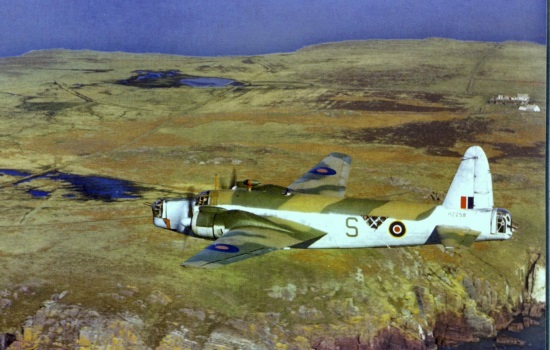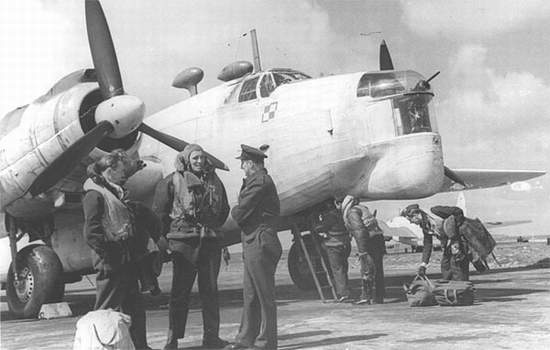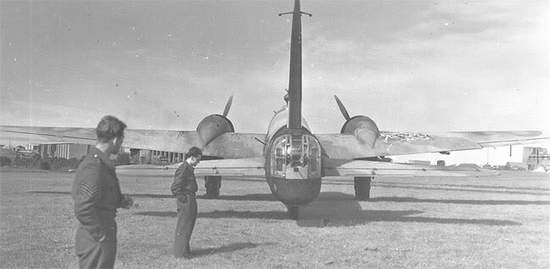
Unequal fight
Bay of Biscay, 9th February, 1943
It was the fourth hour of the mission. The first pilot of the Wellington, Squadron Leader Emil Ladro rubbed his weary eyes and stretched his arms. "An hour to go and we will return to Dale" - he said to the second pilot, Squadron Leader Jan Biały. He responded with a nod. Suddenly, he fixed eyes on a spot on the horizon. The spot kept growing fast and separated into four smaller ones.
"We have got company" - said the copilot to his commander.
Squadron 304 "Land of Silesia” was the third Polish bomber squadron created in Great Britain, after Squadron 300 "Land of Mazovia" and Squadron 301 "Land of Pomerania". The official order has been issued in Bramcote on 23rd August, 1940. At the start it had 185 airmen, including 31 commissioned officers. Most of them had combat experience from the September campaign and fighting in France. In spite of that, during the first months, the squadron had a status of a training unit. The Poles had to go through the crash course of English, learn the numerous RAF handbooks and regulations and above all - to learn the intrinsic details of their new planes - the Vickers Wellington medium bombers.

The days were spent on the intensive training. In December 1940 the squadron was transferred to the Syerston airfield. They got their first combat experience five month later. On the night of 24th April, pilots Sym and Czetowicz have flown two planes in the raid against the German installations in Rotterdam. During the next few days, all crews of the squadron have flown in action and won the invaluable experience. The squadron has also suffered their first losses. In May, 1941, three crews did not return. During the second half of 1941, the squadron has routinely flown over Germany, attacking Cologne, Düsseldorf, Frankfurt and Ruhr. In total, the squadron has flown 214 missions in 1941, losing 47 men. The first months of 1942 were exceptionally hard. The Allies have intensified the raids against Germany and the 304 Squadron did fly almost every night. In April 1942, six crews (36 men) were lost in action. It was difficult to replace the dead; all young airmen went to the operational units after a short training and there was a shortage of new candidates. The 304 Squadron could muster at most six or seven crews.
The RAF command has decided to transfer the decimated unit to the Coastal Command. A new task of the Poles were search and destroy missions against the U-Boots. The missions were less dangerous than bombing Germany and France, but much longer and very tiring. The new base of the squadron was a small, wind-swept Scottish island Tiree in the Inner Hebrides. The airmen have undergone the training in the ocean flights and learned the anti-submarine warfare. Most crews never saw a submarine from the air and mistakes were not rare. One of the Polish Wellingtons mistook a small Rockall island for an U-Boot and attacked it with depth charges. In spite of these difficulties, the airmen soon got accustomed to their new tasks and started regular hunts for the German subs. After some time, the squadron was moved again - this time to Dale in South Wales. Their new region of operations was the Bay of Biscay. The weather was much better than in Scotland and so were the chances for meeting an U-Boot. In August 1942, the Wellingtons of Zarudzki and Nowicki have destroyed two German submarines. Polish crews have become the terror of German sailors.

The Germans quickly recognised the threat and started regular patrols over the Bay of Biscay, using Me-110 and Ju-88 planes. On 9th February 1943, the Wellington with NZ-W marks, with a crew of Flight Lieutenent Emil Ladro, Squadron Leader Jan Biały, Flying Officer Stanisław Płachciński, Corporal Kazimierz Chłopicki, Corporal Wladysław Piskorski and Leading Airman Antoni Ulicki did take-off for a routine patrol flight over the Bay of Biscay. After about four hours of the mission, four Ju-88 were sighted on the horizon. The commanding officer has ordered jettisoning the depth charges and dived to the low level flight over the surface of the sea. The tail gunner has shot down one enemy plane. The remaining three were still threatening the Wellington with heavy machine gun fire, with many hits. Pilot Ladro made desperate attempts to get his plane into most favourable position. The rear turret was equipped with four coupled Browning 7.7 mm machine guns.
One of the enemy planes attacked from above, heavily wounding copilot and nose gunner. The fire also destroyed the sights of the tail turret, but the gunner has suffered only slight wounds and continued to threaten the Germans. Navigator Stanisław Płachciński was observing the movements of the enemy planes and reported them to the sweating commander who did his best to evade the fire. The Germans kept shooting, one hit of the cannon made a hole of almost one meter in the starboard wing of the bomber. The tail gunner was still shooting to keep the German at bay. During the short breaks, when the enemy planes were climbing before attacking, the pilot held the control wheel with his knees to give his arms a rest. After a long time, the Germans have run out of munitions and tried to push the Wellington into water by flying close above the plane. The bomber was flying towards the British coast. The radio operator, Corporal Kazimierz Chłopicki kept calling for help. A British fighter squadron from St. Eval in Cornwall responded to his signals, sending Beaufighter planes. After the unequal combat lasting almost an hour, Germans left their prey and flew towards France. Shortly after landing on Predannack airfield, the Wellington crew learned that the Beaufighters have found and destroyed the three Junkers planes.
It was the longest fight of the allied bomber in WWII. The crew has survived it by the mastery of the pilot and the perfect cooperation of the navigator and tail gunner. An import role was also played by the legendary robustness of the Wellington plane.

After healing, Wellington's second pilot, Captain Jan Biały reported for training of Cichociemnych, which he passed well, taking on the nick name "Kadłub". On the night of27th April, 1944 he was dropped into Poland. He fought in the Warsaw Uprising. He was awarded the Silver Cross of the Order of Military Virtue and the Cross of Valour three times. He died in 1984 in Bytom.
The stroy "Unequal fight" published courtesy of Mr. Mateusz Biskup "Biszop"
Wellington photos from Mariusz Konarski's book "304 Squadron" courtesy of
Stratus publishing
Thank you very much!
